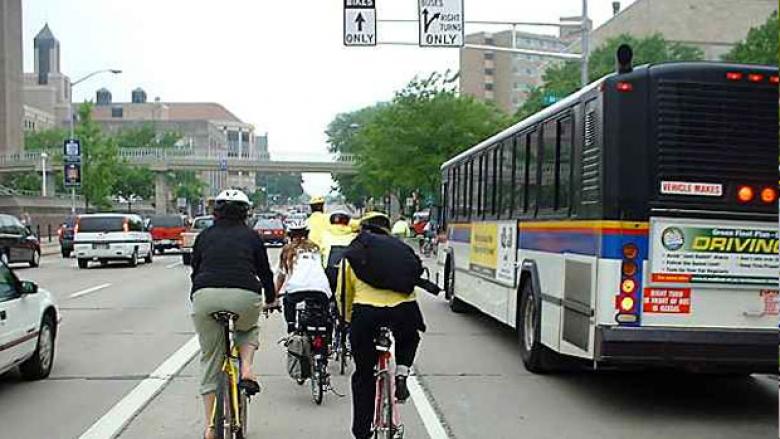
Location
The City of Madison historically has been at the forefront of sustainable transportation planning and design. During the creation of the Eisenhower Interstate Highway System in the 1960s, unlike almost every other major city in the United States, Madison decided not to build an urban freeway through its downtown core. This was the first step towards the creation of a multimodal system that encouraged bicycling, public transit, and walking.
The Wisconsin legislature in 1973 passed a law known as the “three foot rule,” which mandated giving bicyclists at least three feet of space while passing them in an automobile. Shortly after that, Madison adopted its first bicycle transportation plan.
Today, Madison has an extensive network of bike lanes, bike boxes (a roadway engineering treatment that allows bikers greater visibility and a “safe space” to stop at intersections), boulevards, and bike parking spots. These investments in bicycle infrastructure have contributed to an 88 percent growth in bike ridership over the last 11 years. Over six percent of all commuter trips are now made by bike in Madison, which is much higher than the national average.
Madison has also developed an urban bike-share system, allowing users to rent bikes from readily available stations in the city and return them to another station, close to their destination. The system proved so popular that it was expanded shortly after implementation, and now consists of 35 stations across the city, with over 350 bikes available for use.
Madison also has a comprehensive public transit network, with dedicated lanes for buses. The city’s transit system, Madison Metro, had record ridership numbers in 2011. Madison Metro attributed this to significant cost savings (over driving and parking) for transit passengers, improved internet and mobile technology enabling more reliable trip planning for passengers, and convenient access methods such as unlimited yearly ride passes. These successes led to recognition of the system by the American Public Transit Association as the best transit system of its size in North America. The Association cited various sustainability initiatives as factors in their recognition, such as Madison Metro’s use of green power, participation in local sustainability programs, reduction in printing costs through electronic communication efforts, and the induction of 19 hybrid buses into its fleet.
Madison’s transportation investments have resulted in a shift away from driving and towards more multi-modal travel. The Federal Highway Administration estimates that the annual miles driven per-person across Madison’s entire urbanized area decreased from 8,900 per person in 2006 to 7,300 in 2011—the third largest such drop in the nation.


